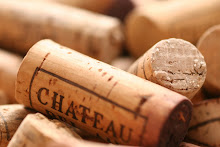
I confess, in addition to speculating in red wines, I like to drink them. So much so, that sometimes the menu gets changed to match wine, rather than the other way around. For instance, when I get interested in consuming an '82 Beychevelle (more of a consumer wine than an investor wine, at $135, having risen from $100 over the last 7 years.), then I tend to schedule a steak to match. But in my household, steak requires an advance appointment with my wife, who could happily eat chicken, fish, and turkey in and endless rotation. What does a red wine lover do in these circumstances? One answer is smoke. Smoke can transform white wine foods into red wine foods.
My first experience with the transformation of white wine food into a red wine food was with salmon. The basic recipe is to 1) rub the salmon with sugar, salt, and pepper. 2) "line a deep frying pan with aluminum foil" - but really you are making a cocoon out of foil to sit in the deep frying pan. The smoke will stain anything it touches, so the foil is not for the cooking as much as it is to aid the cleanup. My advice is to use two layers. 3) put some mesquite chips in the bottom of the pan, add a rack, salmon, and cover tightly with a foil lined cover. 4) put it on the stovetop and fire it up -high flame, 15-20 min. 5) Serve with '89 Sociando Mallet or reasonable facsimile. Chardonnay and dill cream sauce stand down; this is red wine food.
Tonight, I tried a more ambitious version of the aluminum foil cocoon smoker. This time, I used a whole chicken. The main smoking agent was lapsang souchong tea (a tea pre-smoked with pine needles), although to be fair, I included orange rind, star anise, whole cloves, and brown sugar in the smoking mixture. My wife and I had it with an '82 Beychevelle. The match was outstanding, but the credit goes to the smoke -not the cloves or anise. The lapsang souchong is a bit intense for a whole meal (better for an appetizer), and if we had to do it over we might use either oolong tea, or mesquite chips.
The take home message is that you can make red-wine friendly meals, without the red meat. Enjoy.





